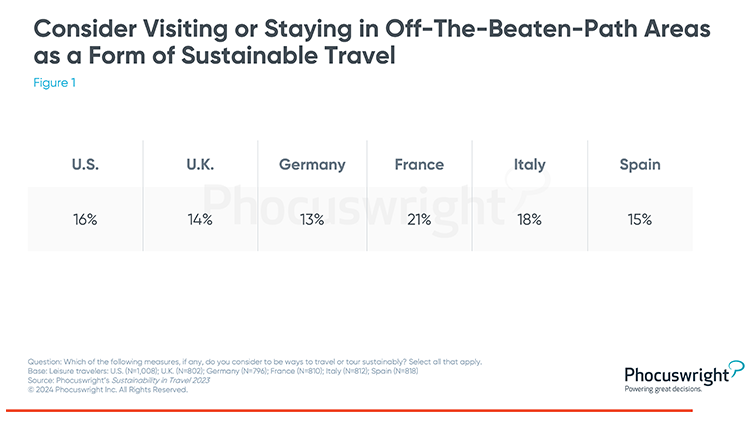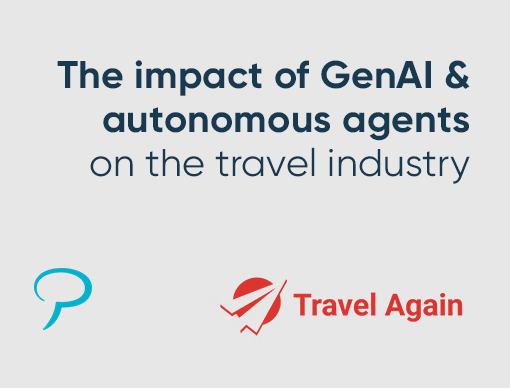Do travelers connect overtourism and sustainability?
- Published:
- January 2024
- Analyst:
- Phocuswright Research
The first step to understanding the traveler's relationship with overtourism is understanding the degree of traveler awareness and concern over it. Within the travel industry, issues of sustainable travel and overtourism go hand in hand according to Phocuswright’s latest travel research report Far From the Madding Crowd? The Truth About Overtourism and Dispersal. But the average traveler does not see an apparent connection between overtourism and sustainability as a cause. Only 13-21% of travelers across markets view visiting less trafficked or off-the-beaten-path destinations as a form of sustainable travel (see Figure 1).
This range is consistent with a broader trend: Travelers don't comprehend what sustainable travel means on a practical level. The measures they understand better are typically environmental ones like recycling, reducing plastics or using public transportation, which can also be adopted at home and have been buoyed by years of public awareness campaigns. Travelers who are sustainability-oriented in their home lives or took recent trips for nature or culture purposes are more likely to know that staying in less-trafficked areas is part of sustainable travel. However, they still display significant knowledge gaps.
Impact of overtourism on trip decisions
Crowding at destinations is a pain point, even though it's not associated with sustainable travel. It affects perceptions of destinations and concerns about what the future of tourism holds. Travelers expressed concerns that issues such as climate change and overtourism would affect future vacations. For those looking to educate travelers on changing their behavior around crowding or draw them into lesser-known destinations, travelers are primed to understand. But they need a push during the trip-planning and booking phases.
Overtourism is a noteworthy cause of active avoidance - choosing where not to go - less so a positive destination selection influence. Across markets, 43-61% of travelers avoided a destination in the past 12 months for a sustainability-related issue. The biggest deterrent was crowding, particularly for French travelers, followed by over-commercialization.
Phocuswright’s Far From the Madding Crowd? The Truth About Overtourism and Dispersal is part of a comprehensive consumer research study focused on sustainability in the modern travel environment.
Specific topics covered include:
- Travelers’ disconnect between overtourism and sustainability, and where further engagement may make a difference.
- Impact of overtourism, climate change and other factors on trip decision making.
- Role of social media in highlighting already-famous places, including what actions DMOs and other formal organizations can take to promote less crowded destinations.
- Dispersal considerations from the side of the travel provider, including infrastructure, marketing and technology recommendations.
For further intelligence for you and your entire company, subscribe to Phocuswright Open Access. This subscription puts the entire Phocuswright research library and powerful data visualization tools at your fingertips. There’s a reason executives around the world trust and reference Phocuswright research and data on a daily basis. Explore for yourself why.
Plus, we just redesigned Phocal Point, the powerful data visualization tool that now makes it easier to access and interpret Phocuswright data.
It's all about the data. With an updated navigation interface, new dynamic filtering, additional segment and channel breakouts in select markets and rich detailed views of 35+ markets, Phocal Point allows you to create custom interactive charts and view travel data by segment, channel, device, region and country. Our proprietary travel industry market sizing data allows you to look to the future with projections through 2026, and review historical data as far back as 2009.












